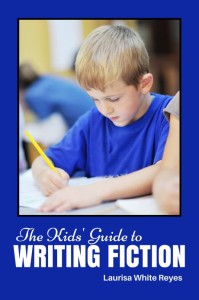“Finding the Joy in Writing”
Any parent knows that if you want a kid to really hate something, just tell him he has to do it, or else. That was my son’s reaction when I told him he had to write a five paragraph essay. My instructions were met with so much whining and moaning you would have thought I’d asked him to scrub the bathroom with a toothbrush. His reaction, however, was not an unusual one. Many parents can attest to their children’s seemingly built-in aversion to writing. While some kids seem naturally drawn to writing, others would rather carry a load of rocks up a mountain than write a compound sentence. This is why I wrote The Kids’ Guide to Writing Fiction, because within every child is a story waiting to be told, whether they realize it or not.
Make Writing Fun
Remember the classic children’s film Mary Poppins? Jane and Michael Banks live in turn of the century London. These conniving pranksters manage to chase away every nanny their father hired for them. Their parents are at their wits’ end. Then Mary Poppins arrives. One of the first tasks she requests of the children is to pick up their room. Jane and Michael balk and whine. To them it is a tedious, pointless chore. What does Mary Poppins do to change their attitudes? She throws in a spoonful of sugar and makes the whole thing a game. In no time at all the room is clean and the children are tucked neatly in their beds.
Now, obviously, real life doesn’t work quite like that. We have no magical carpetbag from which to pull out hat racks and measuring sticks. But as parents and/or educators, we do have the same power as Mary Poppins to create an atmosphere of cooperation and optimism in our homes and classrooms. Whether or not our children will hate what we ask them to do, or do it willingly and cheerfully, depends largely on us.
I started teaching creative writing classes to children and teens about the same time my son was learning to write those essays. I looked for ways to encourage my students to write, and met with great success. Once I applied what I was using in my classes to my son, his attitude toward writing changed. And although it is still not his favorite activity, he has become a capable and skilled writer.
Writing is a Means of Self-Expression
Writing well demands that the writer enjoy writing. When writing is nothing more than an assignment with no purpose except to earn a grade on a report card, chances are that the student will come to dread writing. He will view it as chore, just like washing the dishes or making his bed.
Is this the attitude we want our children to have about writing? Do we want them to write five-paragraph essays just for a grade? Is that really the purpose of a writing education? Of course not. The ultimate goal is for our children to feel confident in their writing skills, to use writing as a means of self-expression. But to achieve that goal requires that we, as adults, help our kids find the joy in writing.
In my writing classes, I taught students how to write. I did not, however, grade anything, nor did I spend much time critiquing their work. In fact, my students didn’t even realize they were learning to write well, because they were so excited about what they were doing. Over the years, I’ve heard from many of my students’ parents about how their children were transformed from reluctant writers to kids who wouldn’t put their pencils down. The key to this transformation was that I made writing fun.
To me, there is nothing more enjoyable than sitting alone at my computer in the middle of the night to write. I would rather do that than just about anything else. The question is, how do we transfer this love of writing to our kids?
The first step in helping kids write well is to take writing out of the picture. Writing is a means to an end, a tool for getting what is inside someone’s head onto paper. What’s really important is the message or information writing conveys.
Think of words as clay. Clay by itself is nothing but a gray lump on a potter’s wheel. But in the hands of the potter, the clay begins to take shape. If the potter doesn’t like the form, he can squash it and start all over again. He can do this over and over until he gets it just right. Once it is finished and the piece is fired and glazed, we see not the lump of clay, but a beautiful piece of art or a functional object, such as a vase.
Writers use words to create something beautiful and useful. They are not as concerned with the words as they are with the finished product. When children focus on that finished product, be it a poem or essay or story, words become tools, the medium by which they can bring their dreams to life.
The Storyteller Within
One the most effective ways to help kids fall in love with writing is by helping them discover the storyteller within. We are all storytellers. A storyteller is someone who relates events in a logical order to someone else. Think about the last time you told a friend about a movie you a saw, or an event you attended, or even just something that happened that was interesting. How did you share that information? Most likely, you told it in the form of a story.
The reason so many children and teens are averse to writing, particularly in school, is because they have not yet tapped in to their own natural storytelling abilities. That is my objective with The Kids’ Guide to Writing Fiction. In this book, I teach kids about the six fundamental building blocks needed to create stories: characterization, setting, plot, perspective, imagery, and dialogue. I take them step-by-step through the process of crafting a story and help them excavate their own imaginations for ideas. Then I help them put those ideas into words and onto paper.
Once a child has written a story of his own, he feels a great sense of satisfaction. He discovers that writing is fun. This discovery is what can tear down the walls of resistance and self-doubt, and can build confidence in his ability to learn other forms of writing, such as those dreaded 5 paragraph essays.
The ultimate goal of a writing education is to teach kids to write well, but if they hate writing, that goal is nearly impossible to achieve. However, once a child discovers the joy of tapping into his own creativity, then, like Mary Poppins’ carpet bag, writing becomes limitless…and magical.
The Kids’ Guide to Writing Fiction
About the Book: We are all storytellers. Whether weaving mythologies in ancient times or describing the plot of a favorite movie today, humans have, since the beginning of time, loved to tell stories. In The Kids’ Guide to Writing Fiction, students explore the building blocks needed to construct a story: characterization, setting, plot, perspective, plot, imagery, and dialog. Then, using these building blocks, they create their own stories.
Accessible to both the struggling student and the budding novelist—as well as to teachers, parents, and even adult aspiring writers, author Laurisa White Reyes presents key elements of story writing and clarifies them with examples and worksheets. Concepts are explained in simple, clear language while gently introducing vocabulary words.The Kids’ Guide to Writing Fiction offers welcome guidance to storytellers of all ages.
About the Author: Laurisa White Reyes is the author of four novels for young readers, including the 2015 Spark Award winner, The Storytellers. She is also the author of The Kids’ Guide to Writing Fiction & Teaching Kids to Write Well: Six Secrets Every Grown-up Should Know. In addition to writing, she also manages to squeeze time into her busy life to teach college English; run her own editorial/publishing business, Skyrocket Press; and be mom to her five children. You can learn more about her at: www.LaurisaWhiteReyes.com.
Thank you to Laurisa for this very helpful post!



